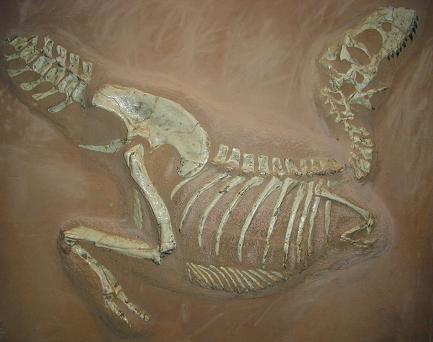Tarbosaurus - Wiki Tarbosaurus
From Wikipedia, the free encyclopedia
[Photo] Tarbosaurus at "Naturkundemuseum M??nster" - M??nster, Germany. Photo taken by: de:User:Thomas Ihle on July 3, 2004. http://de.wikipedia.org/wiki/Benutzer:Thomas_Ihle
Tarbosaurus, meaning 'Terror Lizard' (from the Greek tarbos/ταρβο?? meaning 'fright', 'alarm', 'terror' (interestingly it can also mean 'awe' or 'reverence'[1]) and saurus/σαυρο?? meaning 'lizard'), was a member of the dinosaur family of tyrannosaurids, which flourished during the early Maastrichtian of the Late Cretaceous Period. It is closely related to the genus (and perhaps is indistinct from) Tyrannosaurus.
Discovery and species
Remains have been found in Mongolia, first being described by Evgeny Maleev (pronounced Ma-LAY-ev), in 1955, from fossils recovered in a Soviet Mongolian expedition in 1948. More recently, some teeth and parts of a large pelvis, from a possible tarbosaur, have been recovered from the late Cretaceous Subashi Formation in the Turpan Basin in China[2]. Several tarbosaur teeth have also been recovered, from the Late Cretaceous Nanxiong Formation in Guandong Province in southern China.
Tarbosaurus species
T. bataar (type)
Missassigned (Probable)
T. efremovi (actually young T. bataar)
Size
As with most dinosaurs, Tarbosaurus size estimates have varied through recent years. It could have been 10 to 14 meters long, with a weight of 4 to 5 tons.
Classification
Although many specimens of this genus have been found, little definite data was confirmed on the dinosaur as of 1986, though it was presumed to share many characteristics with other tyrannosaurids. The close similarities have prompted some scientists to suggest a possible link between the North American and Eurasian continents at that time, perhaps in the form of a land bridge. Tarbosaurus may have preyed upon large contemporary hadrosaurs, such as Saurolophus.
http://en.wikipedia.org/wiki/Tarbosaurus
| The text in this page is based on the copyrighted Wikipedia article shown in above URL. It is used under the GNU Free Documentation License. You may redistribute it, verbatim or modified, providing that you comply with the terms of the GFDL. |
